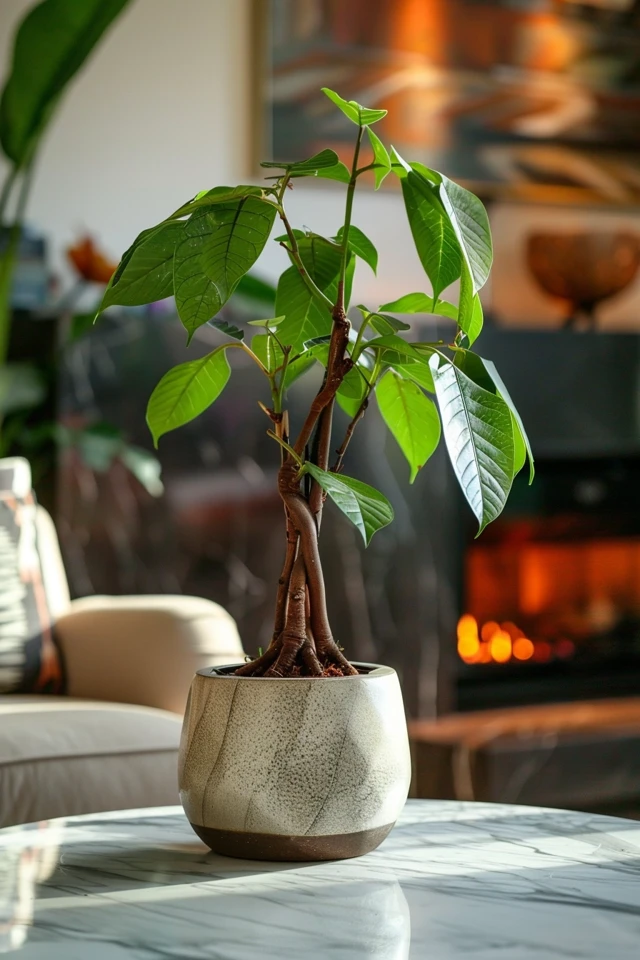Growing a Money Tree (Pachira aquatica) can bring an element of elegance and prosperity to any indoor space. However, if you’re looking to enhance the aesthetic appeal and strength of the Money Tree trunk, you’ll need to employ specific techniques. In this article, I’ll guide you through proven methods to thicken and strengthen your Money Tree’s trunk, ensuring its healthy growth and longevity.
The Money Tree, native to the swamps of South and Central America, can be shaped and trained in various styles. Pruning, a crucial aspect of Money Tree care, involves two main types: maintenance pruning and structural pruning. Maintenance pruning involves removing dead or dying branches and pinching off new growth. On the other hand, structural pruning, typically done during winter, entails selectively removing larger portions of the tree to shape it and encourage growth closer to the trunk.
Proper pruning techniques are essential to prevent infections and diseases. Using sterile and sharp pruning shears is crucial. Additionally, other techniques, such as giving the Money Tree sufficient space in a larger pot, pruning leggy stems, and fertilizing with diluted plant food, can contribute to trunk thickening. Providing the right light and water conditions and conducting winter pruning can also stimulate faster growth.
Key Takeaways:
- Maintenance pruning and structural pruning are essential for shaping Money Trees.
- Using sterile and sharp pruning shears is crucial for preventing infections or diseases during pruning.
- Give the Money Tree ample space in a larger pot, prune leggy stems, and fertilize with diluted plant food to promote trunk thickening.
- Proper light and water conditions, along with winter pruning, can stimulate faster growth of the Money Tree trunk.

Techniques for Natural Trunk Thickening
When it comes to thickening the trunk of a Money Tree, there are some natural techniques that can be employed for optimal results. Let’s take a closer look at two effective methods: growing the Money Tree in the ground or a big outdoor training pot, and using sacrificial branches.
Growing the Money Tree in the ground or a large outdoor training pot allows the tree to develop naturally while providing ample space for root expansion. This method encourages robust growth and the development of a thicker trunk over time. Additionally, pruning any excessive growth helps redirect energy and nutrients towards trunk development.
Another technique to consider is utilizing sacrificial branches. By intentionally allowing a lower branch to grow while regularly pruning other branches, the tree focuses its resources on the main trunk. This promotes the trunk’s development and thickening by directing nutrients more effectively. It’s important to choose a branch close to the base of the trunk to ensure the desired result.
“Growing the Money Tree in the ground or a big outdoor pot allows it to thrive naturally, while sacrificial branches prioritize trunk development.”
While these natural methods may require patience, they can yield satisfying results and contribute to the long-term aesthetics of your Money Tree. Incorporating natural trunk thickening techniques can enhance the strength and beauty of your tree, ultimately creating a more captivating focal point in your space.

Other Trunk Thickening Methods
Aside from the natural methods mentioned earlier, there are additional techniques that can be used to thicken the trunk of a Money Tree. One method is trunk merging, which involves carefully braiding multiple trees together to create a single, thicker trunk. This technique can be visually appealing and effective in creating a strong and substantial trunk. However, it’s important to note that there may be potential risks associated with trunk merging. If any of the trees used in the fusion process die, it can result in gaps in the trunk.
Another technique for thickening the trunk of a Money Tree is cutting back the trunk. This method involves trimming the trunk to about one-third of the desired bonsai height and allowing it to grow out again. By repeating this process over time, a thick and tapered trunk can be achieved. Cutting back the trunk stimulates new growth and encourages the tree to develop a more robust trunk structure. It’s essential to exercise caution and precision when cutting back the trunk to ensure successful results.
When it comes to trunk thickening, the choice between container growing and ground growing is also worth considering. Container growing allows for greater control over the trunk development process. It allows you to carefully shape and prune the Money Tree, ensuring it grows in the desired manner. On the other hand, ground growing can be more suitable for certain plants, as it enables the tree to grow freely and establish a strong root system. The decision between container and ground growing primarily depends on personal preference, growing conditions, and the desired outcome for the Money Tree.

Source Links
- https://thehealthyhouseplant.com/shaping-money-trees-how-to-make-them-taller-bushier-straighter-and-more/
- https://bonsaialchemist.com/learning-center/cultivation/how-to-thicken-a-money-tree-bonsai-trunk/
- https://www.bonsainut.com/threads/best-way-to-develop-thicken-trunks-besides-planting-in-the-ground.43289/page-2

